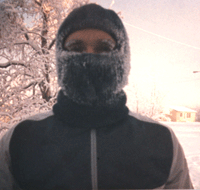The temperature on the department store sign -- seen dimly through the ice fog -- reads minus 55 degrees. That's in Fairbanks, Alaska, where runners, snowshoers and skiers enjoy the outdoors in spite of the worst that winter can throw at them 125 miles from the Arctic Circle.
Conditions in the Midwest aren't nearly as extreme, but runners do need to take some precautions to enjoy an injury-free winter sports routine. And those who do will find that winter running has its own rewards, said Gary Gribble, a veteran of 98 marathons and Kansas City-area running store owner.
"Winter running really can be fun," Gribble said. "There's nothing like being out there in the morning when it's cold and being the first one to put footprints in the snow."
Gribble sponsors a winter running program that offers tips on running in cold weather and organizes weekly group runs.
Some of the group's members were training to run the recent Auburn to Topeka half-marathon, but for many "the main thing is to meet other people to run with," Gribble said.
Even if Midwestern conditions aren't as severe as those in Alaska, there are some common -- and common-sense -- ways to minimize the effects of cold weather and longer hours of darkness.
Dress in layers, to trap warm air around the body, and wear a long-sleeved shirt of polypropylene or other synthetic material that will wick perspiration away from the skin. Add a light, wind-resistant jacket with a zipper you can adjust as you get warmer or cooler.
Wear tights to keep your legs warm, and add wind pants on colder days.
But you usually don't have to wear a lot. When you're deciding what to wear, "always add 20 degrees to the temperature, because your body really warms up," Gribble said.
Wear gloves and a hat. A lot of body heat can be lost through the head. Women may get by with a headband, but "guys should wear knit caps," Gribble said -- especially those who are follicularly challenged. You can stuff a cap in a jacket pocket if it's warm, but it's a necessity if temperatures drop or the wind changes.
Think about safety when you plan your route. Run on trails and paths away from busy streets if possible. If not, then run on sidewalks rather than streets, particularly when it's dark.
"We try to run in areas where there's not much traffic," said Wes Nicholson, a longtime member of Topeka's Sunflower Striders running club.
Carry some form of identification, and choose shoes and jackets with reflective material so that even the most distracted driver can't overlook you.
"Think about reflective trim, even in daylight," Gribble advised.
Try to run into the wind when you start out, so it's at your back when you return. Otherwise, you risk getting chilled by running into the wind when you're sweating.
And don't wear headphones. Be alert to what's around you, whether it's cars or other people.
Run with a friend or group if possible. You're more likely to follow through if you've made arrangements to meet someone, and a friend can provide moral support and help out if there's a problem.
The Sunflower Striders group holds organized runs three times a week, followed by snacks, and members aren't deterred by the weather. "We run rain or shine," Nicholson said, "except when it's real slick."
But on the worst days, or when footing outdoors is really treacherous, go inside, said John Haugh, president of the Tri-Rivers Running Club in Salina.
"What we do is go to the `Y' and work out on the treadmill and rowers and free weights," Haugh said. "If it's a nice day -- meaning not a blizzard -- we go out and jog through the park for three to five miles. That's kind of how we get through the winters."
With everything you have to wear and have to think about in the winter, at least you can get by wearing the same socks as the rest of the year. "There's no reason to change socks, no matter how cold it gets," Gribble said. "And a change of socks affects the fit of your shoes."
And when days are short and conditions dreary in the Midwest, you can always check out the Internet and see what those hardy Alaskans are dealing with -- like the ice fog that hangs over streets and sidewalks when temperatures drop below minus 30.
Running Club North, the Web site of runners in Fairbanks, is at http://www.runningclubnorth.org/lnk_cld1.htm, and there you'll find what real, cold-weather running is like.
Eds: The writer has run 26 marathons and has been a year-round runner for more than 20 years, including running through two winters in Fairbanks.
Copyright 1999 By The Associated Press. All Rights Reserved.
